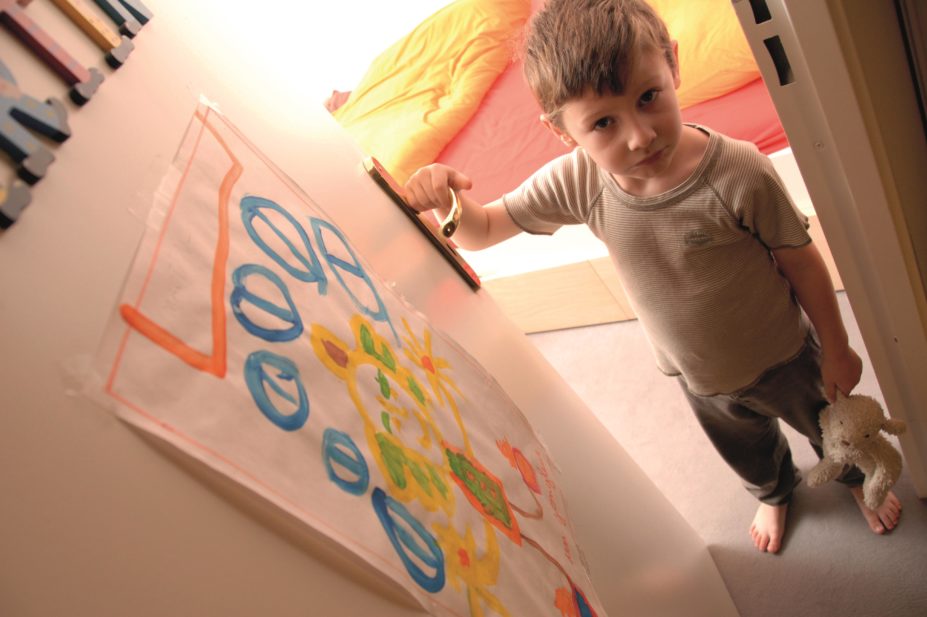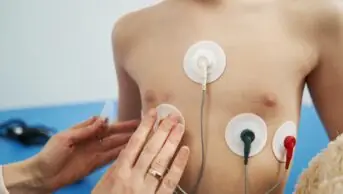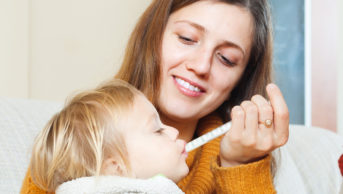
Oredia / Alamy
In this article you will learn:
- The prevalence of nocturnal enuresis in children of different ages
- The possible causes of nocturnal enuresis
- The stepwise management of nocturnal enuresis in children
- Counselling advice for parents and carers of children who experience nocturnal enuresis
Nocturnal enuresis (NE) is involuntary bedwetting during sleep in patients with no congenital or acquired defects of the central nervous system. Inadequate treatment of NE can have psychological ramifications, including impaired personal, social and emotional behaviour[1]
.
Primary NE is a condition in which bladder control has never been attained and NE persists beyond the age of five years. Secondary NE is a condition in which NE presents in a child or adult who has previously been toilet trained and has not wet the bed for at least six months[2]
.
NE that occurs less than twice a week is common in children. Around 21% of children aged four-and-a-half years, and 8% of children aged nine-and-a-half years, wet the bed occasionally; more frequent bedwetting affects 8% of children aged four-and-a-half years, and 1.5% of children aged nine-and-a-half years[1]
. Global and ethnic variation is unclear, perhaps because access to medical attention varies widely and so cases often go unreported.
There is a hereditary link[3]
. Around half of children with one parent who has a history of prolonged NE are likely to be affected by NE, and around 75% of children with both parents who have a history of prolonged NE[4]
. NE is more common in boys than girls.
Although NE can occur in adults, this article focuses on the assessment and management of children.
Causes
The aetiology of NE is not fully understood, although there are three common causes: excessive urine volume, poor sleep arousal, and bladder contractions. Differentiation of cause is mainly based on patient history and fluid charts completed by the parent or carer to inform management options.
Excessive urine production is due to an inadequate amount of, or inadequate response to, antidiuretic hormone (ADH) at night. ADH regulates urine production by increasing water reabsorption in the kidney, and a lack of ADH leads to an overproduction of urine, often beyond the capacity of a child’s bladder.
Poor sleep arousal is when a child is in a deep sleep and is unaware of having a full bladder, and so does not wake to go to the toilet.
Bladder contraction is when a child has the urge to empty their bladder frequently or urgently before it is full. This cause occurs less frequently than excessive urine production or poor sleep arousal.
Assessment
Assessment should begin with taking a thorough patient history to ensure the most appropriate management option, tailored to the child, is selected (see ‘ASMETHOD assessment’). Some parents may find that a diary recording fluid intake, bedwetting and toileting patterns will help in gathering information. Assessment is usually performed over a single clinic visit, which may include ultrasound scanning and occasionally other imaging.
ASMETHOD assessment
The mnemonic ASMETHOD can be used to gather information in nocturnal enuresis (NE).
Age – in general, children should be dry at night by five years of age.
Someone else – check if there is a genetic predisposition to NE in the family history[5]
.
Medicines – what medicines have been tried for NE? If so, what time is the medicine being taken?
Extra medicines – is the child taking any medicines for other conditions? Are caffeinated drinks consumed regularly? What is the child’s fluid intake like during the day?
Time – when did bedwetting start? If it started in the last few days or weeks, could this be linked to a systemic illness?
History – has the child been previously dry, and for how long? If so, investigate potential triggers. What is the pattern of bedwetting: how many times a week does it occur, how many times a night, and what is the volume of urine produced? Does the child wake during bedwetting? Have any emotional triggers been identified?
Other symptoms – are daytime symptoms present? Consider the frequency of going to the toilet (more than seven times a day is considered too frequent, less than four times a day is infrequent), urgency, daytime wetting or dysuria. What are patterns like in other settings, for example at school?
Danger symptoms – the patient should be referred if any of the following are present: severe daytime symptoms; history of urinary tract infections; known or suspected physical or neurological problems; presence of comorbidities, such as diabetes; or emotional problems.
It is important to assess if the child has any other comorbidities, or if other factors must be taken into consideration such as developmental, attention or learning difficulties. The parents should also be asked if the child has been constipated or has a history of soiling themselves. Constipation is a common comorbidity, and sometimes the cause of NE. Soiling may be secondary to faecal impaction and constipation. As the rectum and bladder are very closely situated, when a child is constipated, the stool mass presses against the bladder. This can limit the volume that the bladder would ordinarily hold and also interferes with the sensation of having to urinate, which may lead to enuresis.
Urinary tract infections (UTI) can also be a cause of NE, particularly secondary NE. Signs and symptoms suggestive of UTI may include recent onset of dysuria, fever, haematuria, offensive urine and abdominal pain.
Emotional and behavioural issues may be a cause or a consequence of NE, and may influence treatment outcome. Cases of suspected abuse should be reported to the appropriate local authority or team.
Conditions that should be excluded include diabetes mellitus, diabetes insipidus, chronic renal failure, renal tubular acidosis, renal dysplasia, and Bartter syndrome; these are excluded based on patient history, examination and further examinations. Children with suspected type 1 diabetes should be offered same day referral to a multidisciplinary paediatric diabetes care team[2]
. For symptoms suggestive of type 1 diabetes, see ‘Identifying patients at risk of diabetes’.
Children should also be referred for further investigation by a specialist consultant if they have a history of severe daytime symptoms, recurrent UTI, known or suspected physical or neurological problems, or if the child is not responding to treatment in primary care after six months[6]
.
Management
Parents presenting with concerns about NE in a child younger than five years of age who does not have daytime symptoms should be reassured that bedwetting is common. The parents should be advised to start toilet training the child (if this has not started), and to try using pull-up nappies, or not using a nappy, at night.
In older children, the aim of treatment for NE is to increase the number of dry nights and minimise the emotional impact of the condition. Parents and carers should be encouraged to engage with their child in a positive manner, and establish an environment conducive to helping the child.
One way is to devise a reward system for agreed behaviour that is in the child’s conscious control, such as taking medicines correctly, ensuring an adequate daily fluid intake appropriate for the child’s age (see ‘Suggested daily liquid intake for children’), and using the toilet before bed. Healthcare professionals should reinforce to the parent or carer that bedwetting is not the child’s fault, and punitive measures are not constructive. This will help to protect and improve the child’s self-esteem and minimise feelings of guilt and shame[2]
.
| Suggested daily liquid intake for children | ||
|---|---|---|
| Source: National Institute for Health and Care Excellence | ||
Age | Sex | Total drinks per day |
4–8 years | Female Male | 1,000–1,400ml 1,000–1,400ml |
9–13 years | Female Male | 1,200–2,100ml 1,400–2,300ml |
14–18 years | Female Male | 1,400–2,500ml 2,100–3,200ml |
Parents and carers should be told that treatment of NE is a gradual, stepwise process, which in some cases may require years of continuous therapy.
The information must be tailored to the child and their parent or carer. Pharmacists should give information about any local support groups, and offer practical tips that may lighten the burden on the parent. This may include:
- Bed protectors, washable or disposable products and where these can be obtained;
- Diet and toileting behaviour. Constipation is a common comorbidity that can cause bedwetting and should be treated before NE;
- Explain that lifting and waking the child during the night can have a short-term effect, but does not promote long-term dryness[2]
; - Checking if the child has easy access to a toilet at night, and suggesting placing a potty near the bed.
The benefit of any intervention should be reviewed within an agreed timeframe. If bedwetting continues after advice has been given, an alarm system is usually recommended.
Bedwetting alarms consist of a moisture sensor that sets off an alarm. Sensors are either inserted into underwear or available as bed mats the child lies on. The alarm may eventually condition the brain to recognise a full bladder and urge to urinate. Special considerations must be made for children with learning difficulties or hearing impairment, who may benefit from a vibrating alarm system.
Alarms have the highest long-term success rates for resolving NE, and can be reintroduced if NE recurs[5]
. Alarm treatment may be inappropriate if a parent or carer is having emotional difficulty coping with the burden of NE, or has expressed anger, negativity or blame toward the child. This is because alarms can disrupt sleep for the child and other household members, and the system requires sustained commitment, involvement and effort of the parent or carer.
Progress should be reviewed within four weeks, although alarm systems may take a few weeks before there is an effect, and even longer before dry nights are achieved. Signs of improvement with alarm include smaller wet patches; the child rousing to the sound of the alarm; the alarm sounding off later in the night or fewer times per night; and the child having fewer wet nights. If the child is responding and achieves two weeks of uninterrupted dry nights, the alarm treatment can be stopped.
If there are signs that the child is responding but two weeks of uninterrupted dry nights have not been achieved, continue with the alarm and reassess progress at three months.
At three months, parents or carers should be asked if they want to continue with this treatment option. The alarm system can be continued if they agree, with further reassessment every three months.
If the child does not respond to the alarm system, treatment with desmopressin can be considered in children older than five years of age, either in combination with the alarm or as monotherapy. Pharmacotherapy may also be considered first choice if a rapid response is required.
Desmopressin is a synthetic analogue of ADH. It works by reducing the amount of urine produced in the body by the kidneys, so the bladder fills with less urine at night. Desmopressin is contraindicated if only daytime wetting is present. Other contraindications include excessive thirst, cardiac insufficiency and other conditions treated with diuretics.
Desmopressin is available as a sublingual lyophilisate, which has the advantage of not needing to be taken with water as it dissolves in the mouth, reducing the child’s fluid burden. Nasal formulations of desmopressin are no longer indicated for primary nocturnal enuresis because of an increased risk of adverse effects compared with the oral formulations.
Desmopressin should be taken at bedtime, either as a 200mcg oral dose, increasing to 400mcg if the lower dose is ineffective; or 120mcg sublingual dose, increasing to 240mcg if the lower dose is ineffective. Desmopressin can be given one to two hours earlier in resistant cases.
Patients taking desmopressin should avoid drinking significant amounts of fluid up to an hour before taking the medicine, and for eight hours afterward. Small amounts of fluid, up to a regular cup of water, can be given to quench thirst.
Treatment with desmopressin should be assessed after four weeks, and continued for three months if it is effective. At three months, the medicine should be withdrawn for one week to see if bedwetting has stopped; this approach should be repeated every three months. Routine measurement of weight, serum electrolytes, blood pressure and urine osmolality are not required for children taking desmopressin for NE[2]
.
Children who do not respond to treatment with desmopressin must be referred to a specialist, who can consider alternative options, such as anticholinergics and tricyclic antidepressants.
NICE recommends imipramine as the tricyclic antidepressant of choice for treating NE[2]
. Imipramine should never be used first line in children with NE, and doses should be increased and withdrawn gradually when starting or stopping treatment. Doses are dependent on age; children aged 6–8 years should take 25mg at bedtime; children aged 8–11 years should take 25–50mg at bedtime; and children aged 11–18 years should take 50–75mg at bedtime. Treatment should not normally exceed three months unless a physical examination is made and the child is fully reassessed.
Anticholinergics are most commonly used in combination with desmopressin in NE, and should only be used as monotherapy in children with daytime symptoms. Not all anticholinergics have UK marketing authorisation for use in NE. They should not be used in patients taking imipramine[2]
. Oxybutynin should be considered first for children aged under 12 years; it is not licensed for use in children under five years of age. Tolterodine should be considered in children aged over 12 years, or for younger children who have not responded to oxybutynin. Tolterodine is not licensed for use in children.
Ratidzai Magura BPharm, PGDip Therapeutics is a clinical pharmacist with special interest in paediatrics and public health at Royal Devon and Exeter NHS Foundation Trust.
The author would like to acknowledge the contribution of Vaughan Lewis, paediatric consultant, Royal Devon and Exeter NHS Foundation Trust, in reviewing the article.
References
[1] Butler RJ & Heron J. The prevalence of infrequent bedwetting and nocturnal enuresis in childhood: a large British cohort. Scandinavian J Urol Nephrol. 2008;42(3):257–264.
[2] National Institute for Health and Clinical Excellence. NICE Clinical Guideline CG111. Nocturnal enuresis: the management of bedwetting in children and young people. London: NICE 2010.
[3] Butler R & McKenna S. Overcoming parental intolerance in childhood nocturnal enuresis: a survey of professional opinion. BJU Int 2002;89:295–297.
[4] Bakwin H. The genetics of enuresis. In: Bladder Control and Enuresis. Kolvin RM, Meadows SR (Eds). London: Medical Books Ltd 1973.
[5] Wang QW, Wen JG, Zhu QH et al. The effect of familial aggregation on the children with primary nocturnal enuresis. Neurourology and urodynamics 2009;28:423–426.
[6] Caldwell PH, Deshpande AV & Von Gontard A. Management of nocturnal enuresis. The BMJ (Clinical Res Ed) 2013;347:f6259.


